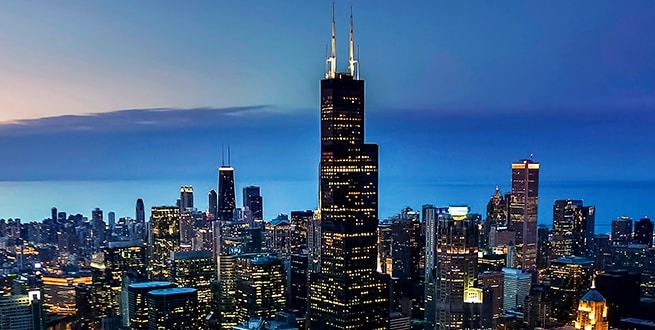Anodizing is a simple electrochemical process developed more than 75 years ago that forms a protective coating of aluminum oxide on the surface of the aluminum.
The lifetime of the finish is proportional to the thickness of the anodic coating applied. Aluminum oxide is a hard, durable, weather resistant substance that protects the base metal. The coating may be colored by dyeing or may exhibit bronze tones through diffraction phenomena produced by the coating. The coating grows from the base aluminum metal through this electrochemical process. The coating is integral to the metal and cannot peel or flake. The structure of the coating is many small hexagonal pores, which are filled with a “seal” that hydrolyzes these pores to fill them with inert aluminum oxide.
The process was used in one of the world’s tallest buildings and the tallest building in America — the 110-story, anodized aluminum-clad Willis Tower (once known as the Sears Tower) in Chicago, Illinois.
Aluminum alloys are anodized to increase corrosion resistance and to allow dyeing (coloring), improved lubrication, or improved adhesion. However, anodizing does not increase the strength of the aluminum object. The anodic layer is non-conductive.
6 Benefits of Anodizing Metal
The unique anodized finish is the only one in the metals industry that satisfies each of the factors that must be considered when selecting a high-performance aluminum finish:
1. Durability
Most anodized products have an extremely long lifespan and offer significant economic advantages through maintenance and operating savings. Anodizing is a reacted finish that is integrated with the underlying aluminum for total bonding and unmatched adhesion. Anodizing is harder than PVDF. Anodizing is better for aluminum in high traffic areas where the coating is subject to physical abuse and abrasive cleaners.
2. Color Stability
Exterior anodic coatings provide good stability to ultraviolet rays, do not chip or peel, and are easily repeatable. Anodizing cannot peel off. The coating is actually part of the metal. Anodizing is unaffected by sunlight. All organic coatings will eventually fail due to exposure to ultraviolet light.
3. Ease of Maintenance
Scars and wear from fabrication, handling, installation, frequent surface dirt cleaning, and usage are virtually non-existent. Rinsing or mild soap and water cleaning usually will restore an anodized surface to its original appearance. Mild abrasive cleaners can be used for more difficult deposits.
4. Aesthetics
Anodizing offers a large increasing number of gloss and color alternatives and minimizes or eliminates color variations. Unlike other finishes, anodizing allows the aluminum to maintain its metallic appearance. Anodizing gives aluminum a deeper, richer metallic appearance than is possible with organic coatings. This is because an anodized coating is translucent, and one can see the base metal underneath the coating. This translucence contributes to color variation problems, but anodizers are doing a much better job of controlling the amount of color variation than in the past. Computerized color matching with quantitative, objective color data is now commonplace in most anodizing facilities.
5. Cost
A lower initial finishing cost combines with lower maintenance costs for greater long-term value. In general anodizing is less expensive than painting except for coil painted products.
6. Health and Safety
Anodizing is a safe process that is not harmful to human health. An anodized finish is chemically stable, will not decompose, is non-toxic, and is heat-resistant to the melting point of aluminum (1,221 degrees F.)
Since the anodizing process is a reinforcement of a naturally occurring oxide process, it is non-hazardous and produces no harmful or dangerous by-products.
Whether you decide you need anodized, powder coated, or to simply paint your metal, choose wisely for longevity, consider the environmental factors, design requirements, and above all, do your homework. All processes are not created equal and the more informed you are about each process and the purpose and use it serves, the happier you will be with the final product.
Contact Tampa Steel & Supply
For more information on anodizing and other processes, such as powder coating or simply using a paint-on product, contact Tampa Steel & Supply.
Request a Quote Online
Or Call Tampa Steel & Supply at (813) 241-2801

